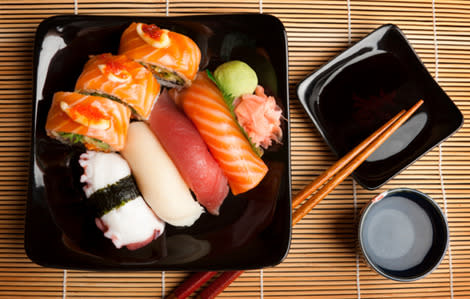The Dangers of Eating Sushi: A Worst Case Scenario Guide

It's just fish and rice. What's the worst that could happen? Let's start with salmonella poisoning. Over 100 people in 20 states have reported symptoms (diarrhea, abdominal cramps and fever), after eating spicy tuna rolls and sashimi.
What you should know about the Salmonella sushi outbreak
Still, my passion for taking risks via lunch is undeterred. I eat sushi in Piven-like quantities, brushing aside the regular threats like some unnecessary green plastic wasabi divider. And despite all the bad press I still subscribe to the belief that my maki combo lunch special is healthier than a Big Mac.
But after a little research, I take it all back.
Put to the Morgan Spurlock 30-day test, raw fish, seaweed and rice might be just as bad as a pink slime burger. First there's the fact that a spicy tuna roll, one of the more affordable and snack-able sushi menu items, averages more calories than a Big Mac, so says the Daily Plate. This is news to me, but at least sushi it isn't low-grade artificial animal shavings, right? Wrong again. Tuna scrape, the flesh-colored spicy tuna believed to be behind the outbreak, is actually a ground-up bone-scraped "back-meat." Not only is the ground tuna chuck low-budget, it's also a harbor for disease, according to an NPR report pegging tuna scrape as "the new pink slime."
Since the outbreak, around 60,000 pounds of frozen yellowfin tuna, distributed at supermarkets at restaurants nationwide, have been recalled. Since particular stock of tuna scrape is frozen, sushi restaurants that serve only fresh fish are unlikely to be affected. In fact, the majority of sushi eaters haven't shown any symptoms of the bacteria. Of the 48 million cases of food poisoning reported in the U.S. each year, raw fish is hardly the lone offender. Cantaloupe, spinach and cooked ground meat have all been on FDA's most wanted list.
What sets sushi apart is the variety of ways its been known to attack. It's highly unlikely you'll ever suffer from a sushi-related illness, but if you do you won't forget it.
You could cough up a worm: When people warn about food poisoning from sushi they usually talk about the nausea, the vomiting and the several hours spent screaming at a toilet. But the interaction with a living creature who just emerged from your body doesn't get nearly the airtime it deserves. The roundworm Anisakis simplex, is one of the bigger threats (pre-salmonella outbreak) of eating raw fish. After the little guy destroys your next 24 to 72 hours by lodging in your intestinal walls he's ready to come out in either direction. That's when you come face to face with a new friend. If you're not lucky enough to cough or "water-slide" the worm out, you'll have to have him surgically removed. On a scale of zero traumatizing, surgery ranks as slightly lower than the cough.
You could partially lose your eye-sight and your skin: Remember when Jeremy Piven got mercury poisoning from too many Nobu binges and everyone balked? Maybe we shouldn't have. A 2008 New York Times investigation uncovered shockingly high levels of mercury in raw fish at some of the world's finest sushi restaurants. The off-the-charts numbers, well above the F.D.A's safety standard, led one physician involved in the study to recommend eating raw fish no more than once every three weeks. The alternative is a host of horror movie symptoms. Possibly mercury poisoning symptoms include: temporary loss of peripheral vision, nerve damage, problems with motor skills, rashes and desquamation-a fancy way of saying 'skin shedding'.
Tips on eating safe, healthy sushi
You could get exposed to radioactive iodine: Well, probably not anymore, but there was a window after Japan's nuclear power plant disaster last year when some experts warned against keeping up a sushi habit. While U.S. food safety officials closely monitored imported foods, and experts believed that the half-life of harmful radiation in fish was swift enough to do no damage to U.S. chowhounds, not everyone agreed. "You're not going to die from eating it right away, but we're getting to levels where I would think twice about eating it," a marine sciences professor at SUNY Stonybrook told the New York Times last year.
Other research scientists warned that the seaweed that holds the rice and fish so deliciously together could collect particularly concentrated levels of radioactive iodine. Worst possible outcome: a build up of radioactive iodine over time could be linked to thyroid cancer. It's not likely any of those fish dinners you ate last year were carcinogenic, but at this point, I wouldn't put anything past sushi.
You could die: Vibrio species are another form of living bacteria that can enter your body through a bite of raw crab on a bed of rice. In addition to the food poisoning trifecta of diarrhea, vomiting and fever, the bacteria can be deadly for those with weakened immune systems or liver disease. Life-threatening septicemia, a fast-acting infection in the blood, has been reported in rare cases. Meningitis, the swift and deadly brain infection, has also been linked in rare occasions to salmonella.
You could have a serious panic attack: Although about 60,000 pounds of contaminated tuna scrape has been recalled, the F.D.A. warns of mislabeled, and possibly, infested fish still lingering in restaurants right now. If you temporarily forget about the current sushi crisis, eat a spicy tuna roll and then remember you shouldn't have, your next 72 hours will be spent wondering whether each stomach churn is a one-way ticket to the bathroom. Another route to a meltdown over your raw fish dinner? Picture "a mouth full of bugs." That's how one food safety inspector described the act of eating bacteria-laden sushi. It almost makes you hanker for some pink slime.
Related:
Signs of deadly food poisoning
What not to eat when you're pregnant
How to eat sushi safely
The best way to avoid food poisoning
